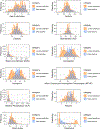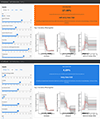Validation of an Electronic Health Record-Based Machine Learning Model Compared With Clinical Risk Scores for Gastrointestinal Bleeding
- PMID: 38971198
- PMCID: PMC11493512
- DOI: 10.1053/j.gastro.2024.06.030
Validation of an Electronic Health Record-Based Machine Learning Model Compared With Clinical Risk Scores for Gastrointestinal Bleeding
Abstract
Background & aims: Guidelines recommend use of risk stratification scores for patients presenting with gastrointestinal bleeding (GIB) to identify very-low-risk patients eligible for discharge from emergency departments. Machine learning models may outperform existing scores and can be integrated within the electronic health record (EHR) to provide real-time risk assessment without manual data entry. We present the first EHR-based machine learning model for GIB.
Methods: The training cohort comprised 2546 patients and internal validation of 850 patients presenting with overt GIB (ie, hematemesis, melena, and hematochezia) to emergency departments of 2 hospitals from 2014 to 2019. External validation was performed on 926 patients presenting to a different hospital with the same EHR from 2014 to 2019. The primary outcome was a composite of red blood cell transfusion, hemostatic intervention (ie, endoscopic, interventional radiologic, or surgical), and 30-day all-cause mortality. We used structured data fields in the EHR, available within 4 hours of presentation, and compared the performance of machine learning models with current guideline-recommended risk scores, Glasgow-Blatchford Score, and Oakland Score. Primary analysis was area under the receiver operating characteristic curve. Secondary analysis was specificity at 99% sensitivity to assess the proportion of patients correctly identified as very low risk.
Results: The machine learning model outperformed the Glasgow-Blatchford Score (area under the receiver operating characteristic curve, 0.92 vs 0.89; P < .001) and Oakland Score (area under the receiver operating characteristic curve, 0.92 vs 0.89; P < .001). At the very-low-risk threshold of 99% sensitivity, the machine learning model identified more very-low-risk patients: 37.9% vs 18.5% for Glasgow-Blatchford Score and 11.7% for Oakland Score (P < .001 for both comparisons).
Conclusions: An EHR-based machine learning model performs better than currently recommended clinical risk scores and identifies more very-low-risk patients eligible for discharge from the emergency department.
Keywords: Electronic Health Record; Gastrointestinal Hemorrhage; Machine Learning.
Copyright © 2024 AGA Institute. Published by Elsevier Inc. All rights reserved.
Figures






References
-
- Laine L Upper Gastrointestinal Bleeding Due to a Peptic Ulcer. N Engl J Med 2016;375:1198. - PubMed
-
- Gralnek IM, Neeman Z, Strate LL. Acute Lower Gastrointestinal Bleeding. New England Journal of Medicine 2017;376:1054–1063. - PubMed
-
- Laine L, Barkun AN, Saltzman JR, et al. ACG Clinical Guideline: Upper Gastrointestinal and Ulcer Bleeding. Am J Gastroenterol 2021;116:899–917. - PubMed
-
- Gralnek IM, Stanley AJ, Morris AJ, et al. Endoscopic diagnosis and management of nonvariceal upper gastrointestinal hemorrhage (NVUGIH): European Society of Gastrointestinal Endoscopy (ESGE) Guideline - Update 2021. Endoscopy 2021;53:300–332. - PubMed
Publication types
MeSH terms
Grants and funding
LinkOut - more resources
Full Text Sources
Medical

